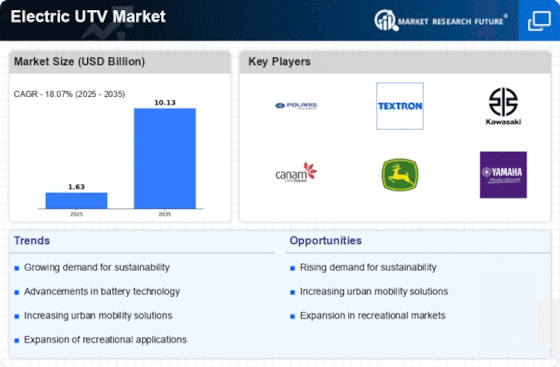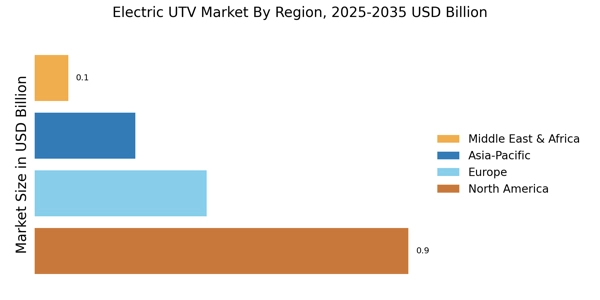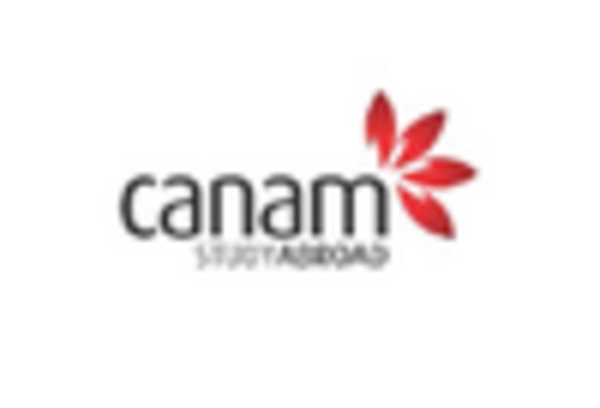Diverse Applications
The versatility of electric UTVs is a significant driver for the Electric UTV Market. These vehicles are increasingly being utilized across various sectors, including agriculture, construction, and recreational activities. In 2025, the market is expected to expand as more industries recognize the benefits of electric UTVs, such as lower operating costs and reduced noise pollution. For instance, in agriculture, electric UTVs are being adopted for tasks like transporting goods and managing livestock, which enhances operational efficiency. The construction sector is also leveraging electric UTVs for site maintenance and material transport, contributing to a projected market growth of 10% in this segment. This diverse applicability is likely to solidify the Electric UTV Market's position as a key player in the utility vehicle sector.
Government Incentives
Government incentives are emerging as a pivotal factor in the growth of the Electric UTV Market. Various governments are implementing policies and financial incentives to promote the adoption of electric vehicles, including utility task vehicles. These initiatives may include tax credits, rebates, and grants aimed at reducing the initial purchase cost of electric UTVs. In 2025, it is anticipated that such incentives will lead to a 20% increase in electric UTV sales, as consumers and businesses take advantage of these financial benefits. Additionally, regulatory frameworks aimed at reducing emissions are likely to encourage manufacturers to invest in electric UTV technology. As a result, the Electric UTV Market is expected to thrive, driven by supportive government policies that facilitate the transition to cleaner transportation options.
Technological Innovations
Technological advancements play a crucial role in shaping the Electric UTV Market. Innovations in battery technology, such as lithium-ion and solid-state batteries, are enhancing the performance and efficiency of electric UTVs. These developments are expected to extend the range and reduce charging times, making electric UTVs more appealing to consumers. In 2025, the market is anticipated to witness a surge in demand, with a projected growth rate of 12% attributed to these technological improvements. Furthermore, the integration of smart technologies, including GPS and telematics, is enhancing the functionality of electric UTVs, thereby attracting a broader customer base. As manufacturers continue to invest in research and development, the Electric UTV Market is likely to benefit from these innovations, leading to increased competitiveness and market penetration.
Sustainability Initiatives
The Electric UTV Market is experiencing a notable shift towards sustainability initiatives. As environmental concerns gain traction, manufacturers are increasingly focusing on producing electric utility vehicles that minimize carbon footprints. This trend is driven by regulatory pressures and consumer demand for eco-friendly alternatives. In 2025, the market is projected to grow significantly, with an estimated increase of 15% in electric UTV sales compared to previous years. Companies are investing in sustainable materials and production processes, which not only enhance their brand image but also align with global sustainability goals. The emphasis on reducing greenhouse gas emissions is likely to propel the Electric UTV Market forward, as stakeholders recognize the importance of environmental stewardship in their operations.
Consumer Awareness and Demand
Consumer awareness regarding the benefits of electric vehicles is significantly influencing the Electric UTV Market. As more individuals and businesses become informed about the advantages of electric UTVs, such as lower operating costs and reduced environmental impact, demand is expected to rise. In 2025, the market is projected to grow by approximately 18%, driven by increasing consumer preference for sustainable transportation solutions. Educational campaigns and marketing efforts by manufacturers are playing a crucial role in enhancing awareness and promoting the advantages of electric UTVs. This growing consumer consciousness is likely to encourage manufacturers to innovate and expand their electric UTV offerings, further propelling the Electric UTV Market into a new era of growth and sustainability.


















Leave a Comment